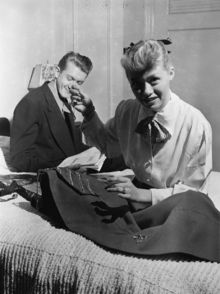City of Glass (Stan Kenton album)
The original album has been reconstituted in different LP re-issues, and the entire set of Kenton/Graettinger Capitol Records sessions is on the digital CD City of Glass.
City of Glass and the whole body of work from the Stan Kenton orchestra and Robert Graettinger (1947–1953) is a direct product of the experimental American music scene of the post World War II era.
[citation needed] Stan Kenton had reformed his orchestra in September 1947 with the avowed intention of playing "progressive" jazz designed specifically for the concert hall.
'[citation needed] Contemporaries of the Kenton/Graettinger collaboration during that time such as Ralph Burns with Woody Herman, Boyd Raeburn (w/Eddie Finckel and George Handy) and Claude Thornhill (w/Gil Evans) help to clarify the important place where City of Glass sits in jazz history, though Graettinger's output and fame was affected by the AF of M recording ban (as compared to those other writers).
[6] Graettinger's intention is far closer to jazz than to the modernism of Russians or any classical music of the time; this makes it no less innovative but merely assigns the lineage to a more accurate place.
The austere nature of his arrangement and use of pantonality (one might call it atonality in spots) makes one wonder how June Christy is able to pick off the 9th of the F minor chord at the top of the tune; there is basically no clue given by Graettinger as to what pitch is coming for the singer (the glue that holds this together is the Bb pedal point at the bottom).
Graettinger's "House of Strings" (Aug 24, 1950) is recorded on a split session with popular Les Baxter sides; the Kenton 'Innovations Orchestra' as a regular touring and studio unit had come and gone quickly due to financial failure.
[12] The group's studio time on December 5 and 7 was entirely devoted to Graettinger's music; primarily the four movement City of Glass suite (add "A HORN" from This Modern World).
[14] Olivier Messiaen's "Mode de Valeurs et Dintensites" (1949) comes to mind with the first opening music of Graettinger's Entrance Into The City (in two parts).
Both are well balanced works successfully set in jazz 'grooves' juxtaposed to tonal dissonance like George Russell's groundbreaking 1949 "A Bird in Igor's Yard" (also recorded by Capitol during that time).
After City of Glass Stan Kenton would add in an odd Graettinger composition during recording sessions until there was enough to press a second 10-inch LP of new material.
This Modern World is varied in scope but lacks greatly what would be real jazz sensibilities; the feature written for Maynard Ferguson entitled A Trumpet (Stan Kenton himself gave it that name) is the only exception on this recording.
After this recording Graettinger's output dwindled and only one other piece is known of ("Suite for String Trio and Wind Quartet") and was still unfinished at the time of his death in 1957.
[16] Bob Graettinger died an untimely death of lung cancer in 1957 at the age of 33; he lived a great deal of his personal life enigmatic and as a loner.
[27] Scott Yanow's AllMusic review states "The 16 pieces arranged by Bob Graettinger which make up this CD number among the most exacting works Kenton was ever responsible for.

Photograph by William P. Gottlieb .


circa 1948
